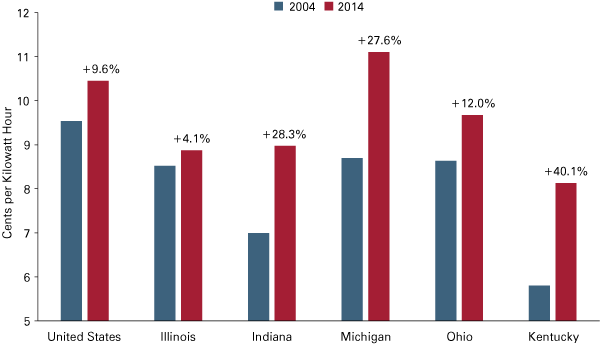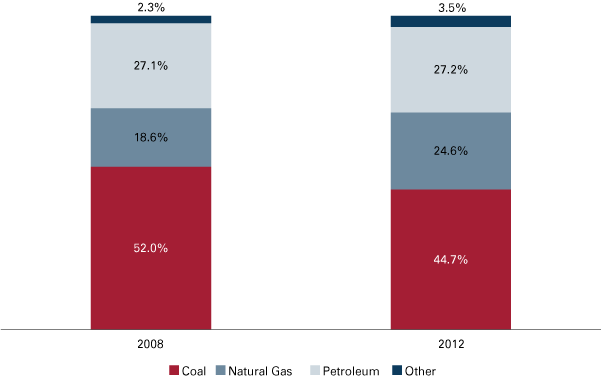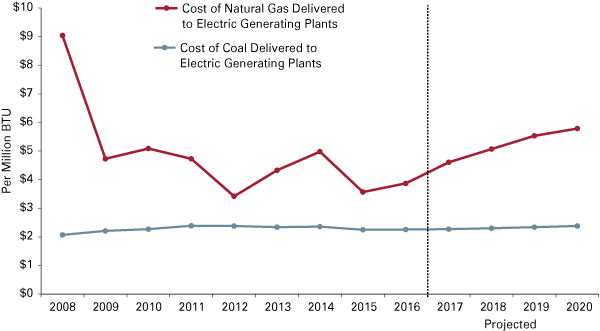The Long View: Indiana’s Energy Outlook
Research Associate, Indiana Business Research Center, Kelley School of Business, Indiana University
Director of Economic Analysis, Indiana Business Research Center, Kelley School of Business, Indiana University
Who knew that when the late Yogi Berra said, “The future ain’t what it used to be,” he was talking about Indiana’s energy future?
Coal has been the linchpin of Indiana energy. On the production side, Indiana is ranked eighth in the country for coal production. In 2014, coal-fired power plants provided about 85 percent of Indiana’s electricity generation. Indiana’s industrial manufacturers of aluminum, chemicals, glass, metal casting and steel consume more energy than the residential and commercial sectors combined. Historically, this reliance on coal by Indiana has kept the price of energy relatively cheap and arguably has attracted industrial companies to locate in Indiana.
The state’s dominance in coal production and use has also led Indiana to have the eighth-highest energy-derived carbon emissions in the United States. Over the last few years, the state has diversified its energy portfolio by moving away from coal. This rebalancing of energy sources has been, and continues to be, motivated by environmental regulations on emissions and largely enabled by the steep drop in natural gas prices attributed to new extraction technologies (hydraulic fracking).
Rates
Historically, Indiana has used its cheaper-than-average energy rates to attract businesses to locate in the state. That said, over the past 10 years, the price of energy for all market sectors in Indiana has increased 28.3 percent from 6.99 to 8.97 cents per kilowatt hour (kwh). The industrial sector was hit even harder, with a price increase of 32.7 percent. Even with this significant increase in price, Indiana still ranks 36th in the nation for energy prices, with the current United States average at 10.45 cents per kwh for all sectors. These electricity price increases have eroded Indiana’s comparative advantage in energy production compared to neighboring states, as Figure 1 shows. The good news is that the price increases have moved Indiana’s electricity closer to prices in border states (with the notable exception of Kentucky).
Figure 1: Electricity Price Changes for U.S., Indiana and Neighbor States, All Consumer Types

Source: U.S. Energy Information Agency
Energy Sources
The dominant energy sources in Indiana and the United States are coal, natural gas and petroleum. In Indiana, coal has been a primary source of electricity generation because historically it has been much cheaper than any other source. Recently, Indiana has been relying more on natural gas. From 2008 to 2012, reliance on coal as a source of energy has decreased 7.3 percent and the reliance on natural gas has increased by 6.0 percent. Figure 2 helps to illustrate this transition.
Figure 2: Indiana’s Energy Sources Breakdown

Source: Lawrence Livermore National Laboratory
There have been several motivating factors for this switch in energy sources. First and foremost, the price of natural gas has dropped significantly over the years, as seen in Figure 3. The fall in natural gas prices has been dramatic, though prices did recover slightly in 2014.
Figure 3: Price War: Coal vs. Natural Gas

Source: U.S. Energy Information Agency
As the price of natural gas decreases, coal-fired plants are finding it financially viable to convert plants from coal burning to natural gas burning. Indianapolis Power & Light’s (IPL) Harding Street Station recently decided to invest $70 million to convert the plant from coal to natural gas. While the price of natural gas is still more expensive than coal, the cost of running a coal plant is more expensive. Coal plants are not as nimble as natural gas and can take significant amounts of time to turn on and off, while requiring advanced technologies to reduce emissions and provide energy. Conversely, natural gas plants require a significant upfront cost to convert plants but are much cheaper to run, with only steam as a byproduct.
While under current conditions it may be cheaper to operate a natural gas plant, rates for Indiana citizens will still increase. The cost of converting plants from coal to natural gas and the cost of decommissioning old coal plants and building new generation facilities are being passed onto consumers. Additionally, as shown in Figure 3, the United States Energy Information Agency is also projecting the price of natural gas to rise, albeit slightly. This will decrease the financial incentive for coal plants to switch to natural gas.
The other factor driving this change from coal to natural gas is that citizens are now aware of the harms of “dirty” coal and the benefits of “clean” natural gas. Environmentalists along with the average “John Q. Public” have been supportive of this switch to cleaner fuels. It is beneficial, therefore, that the market is playing a supporting role in driving the switch in fuel types.
Regulations
Not only are there financial fuel-type considerations motivating the movement away from coal, the United States Environmental Protection Agency (EPA) is hastening the conversion for air-quality reasons—both mercury and air toxin standards, as well as carbon dioxide (CO2). With the support of the White House, the EPA instituted the Clean Power Plan (CPP), which attempts to curb climate change by forcing reductions of CO2 emissions. Under the CPP, Indiana power plants must reduce CO2 emissions 38.5 percent from 2012 levels by 2030. Indiana can do this by burning cleaner fuels like natural gas or by relying more on wind and solar energy, but these latter two energy sources are currently more costly, less nimble and lack the oomph to meet industrial needs. Additionally, the state can encourage citizens to decrease energy demand by using more efficient household goods.
Joining 23 other states, Indiana’s Governor Mike Pence has decided to sue the EPA over the CPP. These states argue that the CPP has gone beyond what is allowed by the law that was established with the Clean Air Act (CAA). The CAA prohibits the EPA from regulating a pollutant from a plant if other pollutants from a plant are already being regulated. However, the EPA states that the CAA prohibits regulating the same pollutants twice. Governor Pence has stated that Indiana may not comply with the CPP even if the rule is upheld. He believes that the CPP will increase prices for consumers too much, reducing their discretionary spending, in addition to putting the jobs of 28,000 Indiana energy workers in jeopardy.
Indiana has one year to submit a plan to be in compliance with CPP. (There is a provision for a two-year extension to rework the plan.) Under the EPA regulation, if Indiana does not comply, the federal government will impose its own plan.
Whether under the market forces of relative fuel price changes to drive Indiana’s gradual energy restructuring, or under the heavy hand of federal mandates to speed up Indiana’s energy transformation, Hoosier energy prices will continue to rise. While these rising energy costs may not be as significant a threat to intermediate- and long-term economic growth and economic performance as cultivating a well-trained, highly skilled workforce, it does erode the state’s short-to-intermediate competitiveness. Irrespective of one’s political views, one can surely appreciate why Governor Pence is resisting the CPP. He is not the only governor who sees the CPP as a credible threat to his state’s economic vitality. While the future is difficult to predict, it would appear that Indiana will not be able to rely on being a low labor cost and low energy cost state, regardless of how the EPA lawsuit is settled.
Conclusion
While workforce development challenges may be more central to Indiana’s long-term economic prospects, the state’s significant rise in electricity costs before the recently announced CPP is to be implemented makes the topic of energy particularly timely. Compared to its border states, Indiana has lost much of its low-cost energy edge, and this trend will likely continue in the next several years. The state, and the country, are fortunate that while coal’s dominance is being regulated out of the energy mix, fracking has dramatically reduced the cost of natural gas and, thus, the cost of transition to cleaner fuels. Whether they come quickly or slowly, long-term structural changes in energy production and consumption is certain. How the state adapts, however, is an open question.
Indiana’s Electricity Rates: All Is Not Lost
In the fall, during the Outlook Panel presentations that the Kelley School of Business conducted across the state, these bleak findings related to Indiana’s coal dependency, the Clean Power Plan and the negative trends in electricity rates in the state over the last 10 years were presented. Several industry executives replied in order to refine the perceptions about Indiana’s electricity costs, lest the average reader conclude that all hope is lost.
The Indiana Manufacturer’s Association (IMA) does concede that Indiana’s advantage in electricity costs has eroded. In 2003, the state ranked as the fifth lowest retail price for electricity in the country. But, the good news is that electricity costs in 2015 were lower than in 2014.1 Among the Great Lakes states plus Kentucky, Indiana’s electricity rates have increased at the second slowest rate since January 2012. Finally, while no longer the fifth lowest, the state currently ranks around the 15th lowest industrial rate over the last year or so (and 10th for all sectors).2 There are some 35 states with more expensive electricity for the industrial sector. Thus, Indiana retains much of its competitive advantage in terms of electricity costs, at least for now.
- http://imaweb.com/energy-update-november-2015/
- “Around the 15th lowest over the last year or so” because the Energy Information Administration, and many of those in the industry, track month-to-month changes in rates and ranks, and at the time of this writing, annual values were not available for 2015: www.eia.gov/electricity/monthly/epm_table_grapher.cfm?t=epmt_5_6_a.




